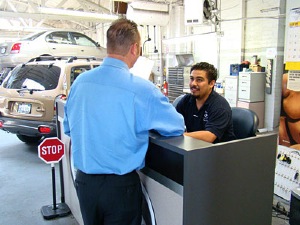 Whether the "selling" part of the job at your dealership is handled by a designated service adviser, service manager, shop foreman or technician, the impact of a "yes" or “no” are the same.
Whether the "selling" part of the job at your dealership is handled by a designated service adviser, service manager, shop foreman or technician, the impact of a "yes" or “no” are the same.
People may decline repairs for numerous reasons. Some you can’t control, but some you just may. Here are a few things that I’ve noticed that I feel increase the odds of having a successful sale:
1. Be Confident and Convinced
A technician tells your service advisor that a vehicle needs a certain new part or a maintenance service, and that link to the customer doesn’t fully understand why. Should they rush over to price it up and sell it? How can they be convincing to the customer if they aren’t completely convinced of the need?
I’m not talking about distrusting your employee, but if your front-line people don’t fully know why something needs to be done to a vehicle, then they won’t sound convincing when explaining the importance of performing the service to your customer.
In a diplomatic manner, find out from the tech not only why an issue should be addressed, but also the benefit to the customer. If the concern involves something visual, like cracks in a belt, they should go back and look at it. “Oh yes, I saw it myself, that belt is cracked almost completely through and ready to pop any day now.” Now they will sound confident and convinced.
2. Don’t Itemize an Estimate To Death
I’ve heard this more times than I can count: “It’s time for a new fuel filter…that’s $XX for the part and $YY for the labor to install it, and you also need a new water pump…that’s $ZZ for the part and $AA to install it”… It’s goes on and on from there.
In this situation, there is more than one reason why the customer would be completely baffled as to what the final price will be. Your service advisor just hit them with so many numbers that they’re now totally lost and just want to leave.
Unless your state has a law that requires itemized estimates, then keep things simple. You might think you’re just thoroughly explaining to your customer where their money is going, but all you’re doing is confusing the one thing the customer truly wants to know: How much will it cost to fix it.
Why subject a customer to the agony of watching their bill creep up? You’re raising the bill and haven’t even worked on it yet!
Just add all parts, labor, any shop supplies and taxes together for all services combined into one single price. Explain each recommended service to the customer and the benefits to each. Then, when you’re done, give them the total “check writing” price.
A few customers may want itemized details, so be ready to cooperate. Others may select one or two items to not do at that time, so have your calculator ready to quickly subtract those items from the quote for a new estimate.
3. Use a Checklist
Many dealers use them, but do you use your checklist during the sale? Most checklists I’ve seen are set up with a list of inspection items with "pass" or "fail" boxes to check.
Let’s say the tech’s inspection shows only one thing that needs attention. For the sake of discussion, let’s say it’s the belt and it’s located half way down a checklist of other items that pass inspection. Completely fill out the checklist, including the one item as failed. Then, when you approach the customer to sell the item, have the completed checklist in hand and visible to the customer.
Most customers can’t look at a car to determine its condition, that’s why they bring it to you. But, they can look down a “report card” and see that their car is getting all “As” in every subject except for that one. That checklist effectively sold the new belt for you.
You can enhance this by casually referencing the rest of checklist. Simply hold it out as you mention the offending item, and drag your index finger down past all of the passing check marks before stopping at the one failing one. Usually the customer’s eyes will follow your finger down the page. They will see each inspection result leading up to that one bad one – every passing mark being a sigh of relief.
Be sure to finish your sales approach with “and we can do that today” (assuming it can be done that same day). If they decline the service, hand over their copy of the checklist and leave them with a smile and invitation to return when it is most convenient to them to have the service.
A certain percentage of those customers will change their mind and come to you in a minute or two to tell you to “go ahead and fix it.” Some may let that checklist – that they can now touch and study – sway their decision. Others may start to think about your last words to them of coming back “when it is convenient.” The customer may decide that there is no time more convenient than now to get it done.
But if the customer declines the service at this time, then be sure to staple their copy of the checklist to the final invoice. You can even have the initial the checklist to indicate that they are declining the service. Many people will toss their paid invoice into the glove box. Months later, they will find that invoice in the glove box with a big-old reminder attached to it.
4. Talk About the Car in Front of the Car
It’s funny when you think about it, but I swear it helps. If your shop is set up to allow this, bring your customer from the lobby out to the vehicle to talk. Many people give objects – like their cars – human qualities. Ever heard a customer say that “she’s not been feeling well lately” in reference to their car?
Some people even name their car. I had high school friend that named her late-1980s Honda Accord “Scooter.” She’d talk about “Scooter” as if it were a person. I had even ridden with her in “Scooter” and had seen her pet and pat the dash of the car and say things like “that’s a good boy” after winding that little 4-cylinder out to get around someone in traffic.
That type of person is a prime candidate to speak with in front of the car when presenting your sale. Those people are hesitant to say “no” where their car can “hear” them.
You may wonder about people who look at a machine as though it was a person, but I’m willing to bet that most of you reading this article have done that very thing. If you own a boat, then you’re almost certain to have done it. The only real issue here is how deeply one person may do it. Deeply enough to say “yes” if it means healing their sick “friend” or keep from hurting it’s “feelings.”
5. Find a Quiet Phone
Stop trying to call customers from a phone inside the service area. You need for a sale to go orderly and professionally, and it’s best to do that in a quiet place.
Talking to someone on the phone is quite different than talking to them in person. When a person is there in your shop, a little bit of shop noise is to be expected and just adds to the experience. But over the phone, there’s a new set of rules. You have to remember that they’re not in a shop when you’re talking to them. They’re in their home, office or out shopping somewhere.
When you call, you’re an allowed intrusion into their environment. That’s right, you are an intruder. You’re a tolerated disruption to their work or private time for the sole purpose of telling them what is wrong with one of their largest possessions and how much it will cost them to have it fixed.
Your voice is invited into their space, but the sounds of that impact wrench or that guy in the shop who sings (out of key) to the radio are nothing more than a nuisance intruding into their space. Not to mention that sometimes a phone will amplify those sounds and the customer may not be able to hear you at all.
So, find a quiet phone where they can hear you and you can hear them. Most importantly, you won’t annoy them.













